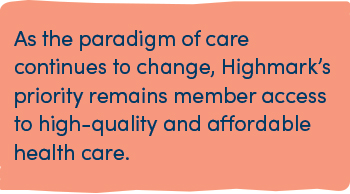
 In March of this year, Highmark Inc. welcomed Jason Renne as the new Senior Vice President of Provider of Partnerships and Contracting. Renne has over 20 years of experience working in the managed care industry including organizations such as Banner | Aetna, Geisinger Health Plan, XLHealth and Kaiser Permanente. His experience has allowed him to work in the for-profit and nonprofit sectors of health care both regionally and nationally, which has shaped his unique view of how health care should be managed most effectively.
In March of this year, Highmark Inc. welcomed Jason Renne as the new Senior Vice President of Provider of Partnerships and Contracting. Renne has over 20 years of experience working in the managed care industry including organizations such as Banner | Aetna, Geisinger Health Plan, XLHealth and Kaiser Permanente. His experience has allowed him to work in the for-profit and nonprofit sectors of health care both regionally and nationally, which has shaped his unique view of how health care should be managed most effectively.
How have your prior experiences in health care shaped the way you approach the payer-provider relationship?
My philosophy on how payers and providers can best work together to serve our communities has been formed by my experiences with highly evolved integrated health organizations that are committed to fundamentally changing the way health care is both delivered and financed. I believe that this is achieved by ensuring that the mission, economics and shared resource allocation between payer and provider are fully aligned towards making health care affordable while improving the quality and experience for both patients and members when accessing the system.
The fundamental key to achieving success is through full organizational commitment to delivering meaningful value to the communities served. This requires recognition that the antiquated fee-for-service payment model is not sustainable and ultimately will not reverse the trend of rising health care costs to employers and families across the country. My experience has taught me that both the payer and provider must embrace this strategy to see significant change.
What was it about Highmark’s mission/vision that attracted you to the organization?
 I’m most energized by the “getting health care right” segment of our mission. It emphasizes the unique position to leverage our Integrated Delivery and Finance System (IDFS) and external provider partnerships to truly transform health care through a spirit of collaboration. When we are committed to creating as little abrasion as possible so that the providers can focus on providing high quality affordable health care, our members are better served. We are continuously trying to find the balance between not forcing our providers to jump through hoops that aren’t valuable and at the same time, being responsible with the dollars we earn from our customers.
I’m most energized by the “getting health care right” segment of our mission. It emphasizes the unique position to leverage our Integrated Delivery and Finance System (IDFS) and external provider partnerships to truly transform health care through a spirit of collaboration. When we are committed to creating as little abrasion as possible so that the providers can focus on providing high quality affordable health care, our members are better served. We are continuously trying to find the balance between not forcing our providers to jump through hoops that aren’t valuable and at the same time, being responsible with the dollars we earn from our customers.
What are your top priorities over the next few years?
How do you see Highmark changing payer-provider partnerships in the future?
We are evolving differently than the general industry. Even though every health insurer has some form of pay-for-performance program in place, many have become stale and redundant. They are not as effective as they once were. However, Highmark has pioneered its value-based platform in a way that goes above and beyond a lot of the off-the-shelf versions by committing to sharing risk with as many providers as possible. While we will never get to a place across our entire network where every provider is in a downsized risk- sharing position with us, Highmark is committed to moving our providers in that direction. We want to align incentives with our providers so that the cost of care decreases while the quality of care can increase.
When you joined Highmark back in March, the country was just starting to tackle the Covid-19 crisis. How has the current crisis affected Highmark’s health strategy going forward?
Deep relationships with providers remains core to our strategy. These provider relationships ensure network viability, enable the transition to value-based care, improve patient and clinician experience, and lower total cost of care. However, the current environment has created new challenges and opportunities that we need to also consider and address.
Members are accessing health care through virtual care more now than ever before. Providers who were already advanced in virtual care and telehealth are moving to the next level. Others who were only dabbling in virtual care and telehealth made great strides in a short amount of time to maintain a level of economic stability.
 By expanding our fee schedules and accepting hundreds of additional codes in the telehealth space, Highmark has enhanced the ability for providers to be reimbursed through this technology.
By expanding our fee schedules and accepting hundreds of additional codes in the telehealth space, Highmark has enhanced the ability for providers to be reimbursed through this technology.
Moving into the “new normal,” we want to ensure that telehealth services provided to our members are of value and where possible, equivalent to being in a doctor’s office (as far as the results are concerned). As the paradigm of care continues to change, Highmark’s priority remains member access to high-quality and affordable health care.